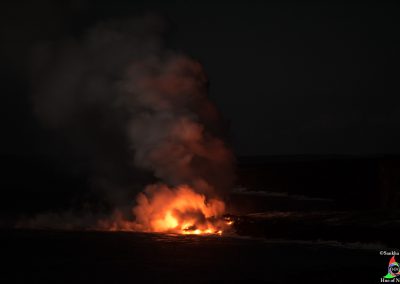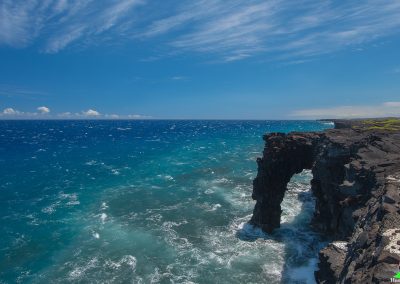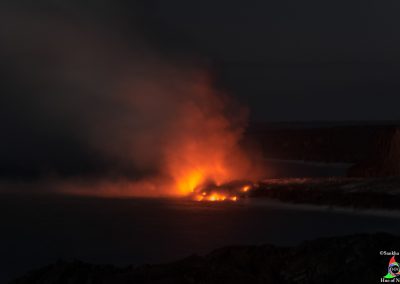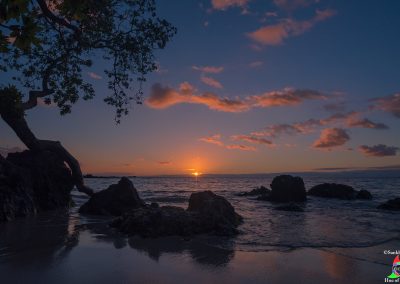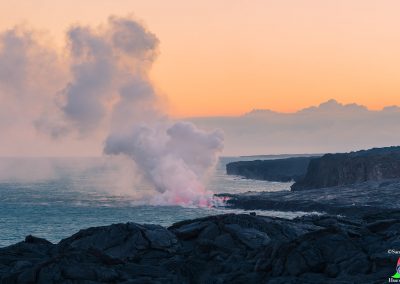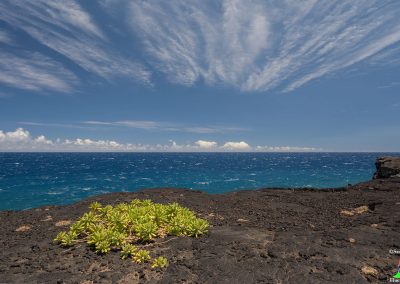Hawai`i Travelogue: Part 3
Three Nights in Big Island (Hawai’i)
– Hawai`i is the largest of all islands in the Hawai`ian archipelago. Nicknamed as “Big Island”, this geologically youngest island of Hawai`i befittingly earned the moniker due to its staggering size that can fit nearly twice the combined landmass of rest of the Hawai`ian islands. From artesian springs, magnificent waterfalls and jet-black sand beaches along Hamakua coast to towering dormant volcanoes Maunakea and Maunaloa; from sweeping vistas, elevated lookouts and scenic hiking trails of lush Waipio Valley to snow-capped heights and mars-like arid landscape of Maunakea; from molten magma flowing into the sea from erupting Kīlauea shield volcano to lava tubes, glowing craters, steam vents and sculpted sea arches in Hawai`i Volcanoes National Park – the island of Hawai`i truly manifests nature’s forces of creation and destruction in an unrivaled way. Big Island, therefore, was not to be missed and we chose this island to be our final destination of week-long Hawai`i vacation in July 2017.
Day One
On a bright, sunny morning of July 5th, we landed at Hilo International Airport around 10:10 am, taking a short 40-minute flight on Hawai`ian Airlines from Maui to Big Island. Car rental pick up at Hilo was conveniently located right across the airport gate, so we could start the 75 mile long drive from Hilo to Mauna Kea Beach Hotel (our first stay in Big Island) rather quickly after landing in Big Island. The scenery on our way kaleidoscopically changed from lush greenery to arid scrubland and eventually to broad volcanic terrain on both sides of Saddle Road, dotted with scattered rocks on the lava plateau of Mauna Kea. Driving for close to two hours through the swiftly changing landscape of Big Island, we reached Kohala coast, where sits our lodging property in an exotic oceanfront setting at Kaunaʻoa Bay. The Mauna Kea Beach Drive leading to the resort from HI-19 Hwy was beautifully landscaped with lined-up palm trees, vibrant flowering Plumeria along the side walkways and lush green golf courses. Established in 1965, this Autograph Collection Property of Marriott paved the way of tourism to Hawai`i’s sunny, western Kohala coast and is a historic landmark of Big Island till today. We were greeted warmly at the reception, with signature orchid and kukui nut leis of Hawai`i, refreshing tropical drinks and a free upgrade to ocean-view room. A friendly staff walked us through the spacious property to our room. On the way, we found an impressive collection of antique Pacific and Asian art pieces displayed all over the property in nooks and corners, adding to its unique character.
Day Two
We stayed at Mauna Kea Beach Hotel for two nights, and pretty much spent the entire duration of our stay in the resort property, either hanging out in the beach, relaxing beneath the beach umbrella and sipping tropical drinks or tasting delicious seafood in the signature restaurants around. Out of the four resort restaurants, we checked three – Copper Bar and Manta Restaurant for fine-dining experience and Hau Tree for beach-style lunch. While Copper Bar with live music was delightful, we liked Manta Dinner the most for its wonderful outdoor sitting with stunning view as well as delicious breakfast and dinner dishes. The location of the Manta Restaurant is also iconic, with the view of swimming Manta Rays near the shore from the open terrace being absolutely amazing. We checked out an interesting breakfast place by the name “Under the Bodhi Tree” the second day while roaming around the neighboring Mauna Lani drive and marketplace. Their fresh fruit platter was refreshingly delicious. Spending the rest of the day in the white sand beach, we retired to our room after watching the last sunset of our trip from the seashore, being rejuvenated for setting out for the final adventure of our trip to the volcanoes the next day.
Day Three
After having a sumptuous breakfast, we checked out from the resort and headed for our next destination: Kalapana lava flow at ocean entry. We planned to stay close to Kilauea in Big Island (the most active volcano on earth), so that we can explore volcanic activities until late night. Driving close to 100 miles, we arrived at “Aloha Happy Place”, a homestay off the Old Volcano Road and only couple of miles away from Hawaii Volcanoes National Park around 2:30 pm. After waiting for close to an hour, we got access to our room (no provision of early check-in). It was a bit strange that there was only one single switch in the room to on/off both the lights and the ceiling fan; which means at night the guests cannot use the fan (otherwise the lights will remain on) and the only source of air circulation would be an open window. We initially thought it would be quite uncomfortable in hot and humid Hawaiian summer to sleep at night without air-conditioning or even fan, but the hostess assured us saying that the temperature usually drops drastically at night (all around the year) near Kilauea and we might, in fact, need a blanket even in summer nights! No wonder Big Island is one of the most climatically diverse places on earth, where not only close to a dozen different climatic zones exist within a single island, but also the temperature within a single zone may vary widely from morning to night.
Soon after checking in, we set out for Kalapana lava viewing area near the ocean entry point, close to 60 miles from our homestay. From the end of Chain of Craters Road, the hiking trail to lava ocean entry viewing begins and it’s close to 9.5 miles moderate, round trip hike along a gravel road with slight elevation gain. An alternate option is to rent bikes that makes the journey much quicker. We opted for the second option and reserved a tandem bike online from Kaimu Bike Rentals to be picked up at 5:30 pm. When we arrived on time, the bike was ready for us. Though there are quite a few bike rental agencies there, it is recommended to have a prior reservation, so as to avoid unpredictable delay in getting a bike onsite, especially during the busy time of the year. Along with the bike, we were also provided additional gears, including flashlights, helmets, bike-lock, water and first aid kit for our journey. The environment here is harsh on bikes and though the brakes and gears of our bike were working fine, it was not a very smooth ride. We were extremely cautious while biking up or down the elevation of the unpaved trail, since the surface with loose gravels was rough. In fact, we witnessed a young biker tumbling down-slope while trying to cruise fast and ending up with a profusely bleeding, badly injured knee. The surrounding view along this trail is of lava fields, parts of which are quite brittle. There is absolutely no shade along the entire 9.5-mile stretch; so even tandem biking was strenuous under the scorching heat of summer sun. We stopped a few times on our way to catch breath and drink water to keep ourselves hydrated. Though the 4.5-mile trail is mostly flat, the hiking/biking experience here is very different from other conventional nature trails and it is highly recommended to take it slow. The hot and dry atmosphere added to the rough, arid terrain can easily make hikers and bikers exhausted if pit stops are not taken at regular intervals. It took us close to 45 minutes to reach the end of the trail at an easy pace, where we locked our bike and hiked over the lava rocks for a short distance (close to 15 minutes) to reach the lookout point to observe the 61g lava flow into the Pacific ocean.
Lava splatter at Halema’uma’u crater as viewed at night from Jaggars museum overlook
Day Four
On the last day of our trip, we started a bit late. Our plan was to spend close to 6 hours in driving through the two main scenic drives in Hawai`i Volcanoes National Park, viz. Crater Rim Drive and Chain of Craters Road, and explore volcanic activities in the park before heading to Hilo to catch our return flight. On our way to Kīlauea Visitor Center, we noticed near the entrance of the park (about 1.5 miles inside the park gate) that some events were ongoing in the Kīlauea Military Campground. At the visitor center, we got to know that it was the day for 37th Annual Hawai`ian Cultural Festival & BioBlitz event at the park, where all park visitors are invited to enjoy hula and music, engage in authentic Hawai`ian cultural practices, watch skilled practitioners demonstrate their art and even get to try their own hands at Hawai`ian crafts! Along with the cultural showcase, the festival also offers a unique opportunity called “Bioblitz”, where visitors can join scientists to discover the biodiversity that thrive in the park. It was indeed a nice coincidence to visit the park on the same day of their annual cultural festival. But we didn’t have much time in hand to enjoy the festival before exploring the rest of the park within half-a day, so we had to skip the Bioblitz for the next time.
Driving along the Crater Rim Drive (close to 11 mile long scenic drive) past the visitor center, we fleetingly stopped at Sulphur Banks (stop 2), Steam Vents and Sulphur Bluffs (stop 3) before reaching the Kīlauea overlook (stop 4). Stops 2 and 3 would surely remind anyone who has been to Yellowstone National Park, of the steam vents oozing SO2 and H2S. One of the differences between Yellowstone and Hawai`i Volcanoes National Park, however, is that there’s no hot spring or geyser near the steam vents here (unlike the ones in Yellowstone) due to deep underground water table. In Hawai`ian mythology, it is believed that Kamapuaa, a half-pig-half-man demigod would stand at Steaming Buff and call his lover Pele, the Goddess of Fire.
Crater
Holei Sea Arch viewpoint and surrounding area
Aloha Hawai’i
Trip summary at a glance:
- Flight: OGG to ITO with Hawaiian Airlines Economy, booked via United Airlines with 6.5K points pp. We returned using 45K pp United Airlines points which was expensive due to 4th of July Holidays.
- Hotel: 2 nights at Mauna Kea Beach Hotel, Autograph collection, Waimea (Marriott Category 9, 90K points), one night at Aloha Happy Place, Volcano ($175 paid stay).
- Places of interest visited in this trip: Mauna Kea, Kalapana, Volcanoes National Park, Holei Sea Arch.
Few suggestions based on our experience:
- Check-in luggage fee: We paid $15 for one check-in luggage in Hawaiian just by being a member (for free) of the airline. For non-members, the fee is $25.
- It is better to tour Volcanoes National Park first and then relax so that one can have time to rejuvenate.
Note:
- Recently, severe volcanic activities have been reported in Big Island and many things have changed. Situation in the places, described above, may have changed significantly and several places may not be accessible any more. We suggest readers to take precaution and check current conditions before planning to travel to Big Island to visit Volcanoes National Park.
- Although we can not do much from here, our thoughts and prayers are with the people of Big Island and those who are affected by the recent volcanic activities.








